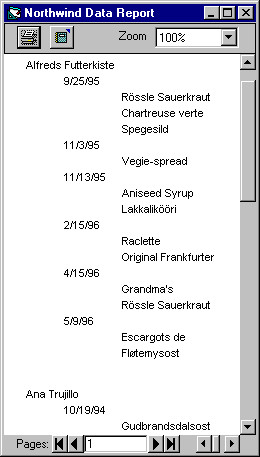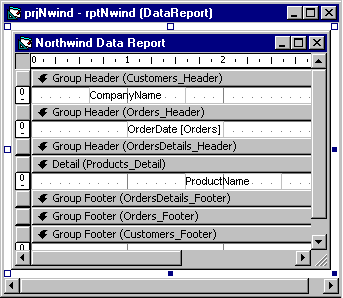
Once you have a simple data report, it's easy to extend it and make a more complex presentation. In the procedure below, the data environment is first extended with the Order Details and Products tables. The extended report includes the names of products ordered on a specific date, and resembles the figure below.
Extended Data Report With Order Details

Note This topic is part of a series that walks you through creating a sample data report. It begins with the topic, Creating a Simple Data Report.
To extend the data environment
| Property | Setting |
| Command Name | OrderDetails |
| Connection | Northwind |
| DataBase Object | Table |
| Object Name | Order Details |
| Property | Setting |
| Command Name | Products |
| Connection | Northwind |
| DataBase Object | Table |
| Object Name | Products |
Once the data environment has been extended with new tables, you can extend the data report as well by dragging fields from the Data Environment designer to the Data Report designer.
To Extend the data report
Clearing this option deletes the page header and footer, which are not being used at this point.
The dialog box allows you to determine if the new header and footer will "bracket" other header/footer pairs. This becomes important as you add more header and footer pairs because the outermost pair of header/footers subordinates all other pairs. This is discussed in greater detail in "Parts of the Data Report."

The figure above requires some explanation. First, the Group footers are all closed in order to take up the least possible space. Like the Details section, any additional space left in any header or footer will be multiplied in the final report. Therefore, if a header or footer doesn't contain any fields, you can close the distance between the headers or footers.
The Group Header named OrderDetails_Header is also closed. If you wonder why no fields are being shown, you must understand that the Order Details table in the Northwind database is a join table—the table contains only the IDs of records from the Orders table joined to IDs of records from the Products table. Thus the Order Details table doesn't contain fields which are actually displayed. Instead, it functions only to join two other tables. In the Data Report designer, the Order Details table therefore functions only to create groups of records—the product names grouped under the order dates.
Finally, the Details section contains only the names of products. The Details section contains the innermost level of repeating records.
This topic is part of a series that walks you through creating a sample data report.
| To | See |
| Go to the next step | Adding a Calculated Field to the Data Report |
| Start from the beginning | Creating a Simple Data Report |